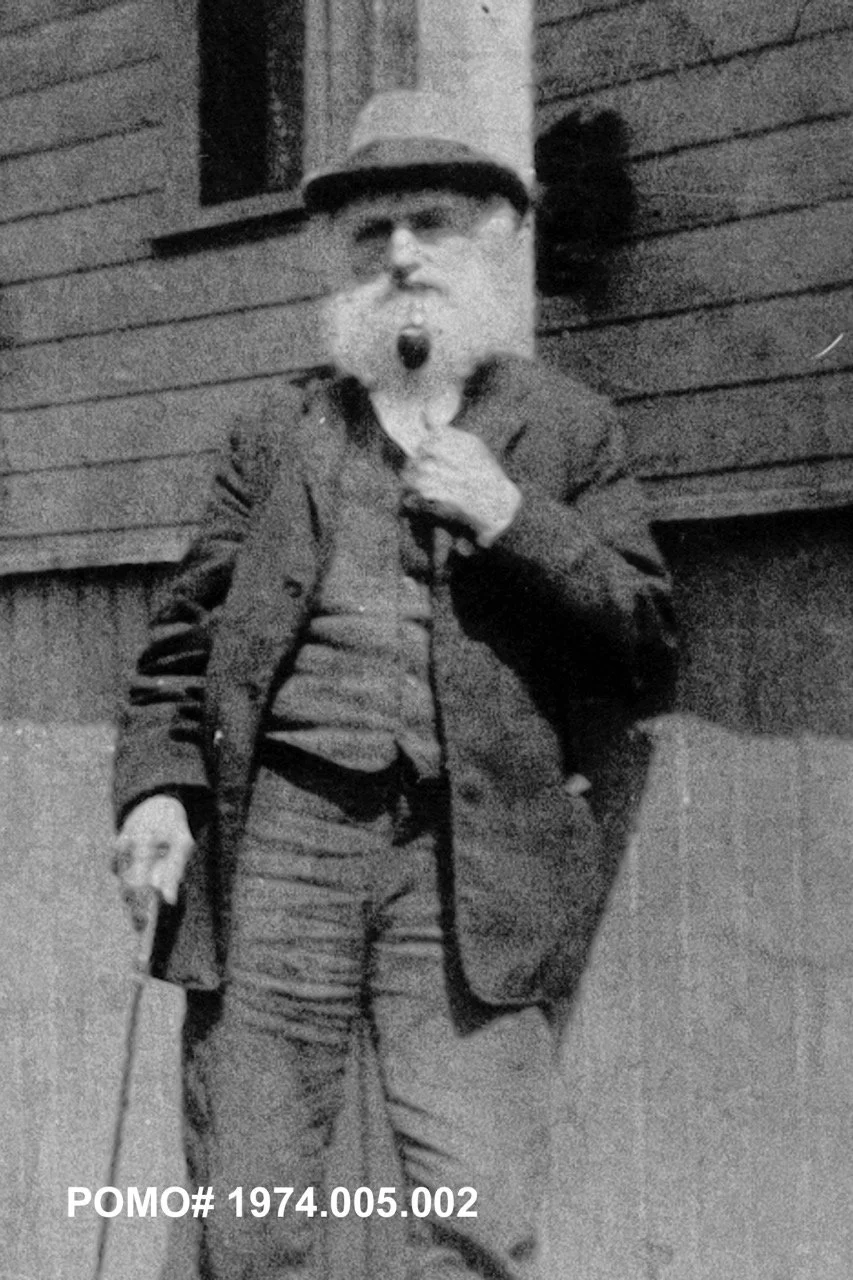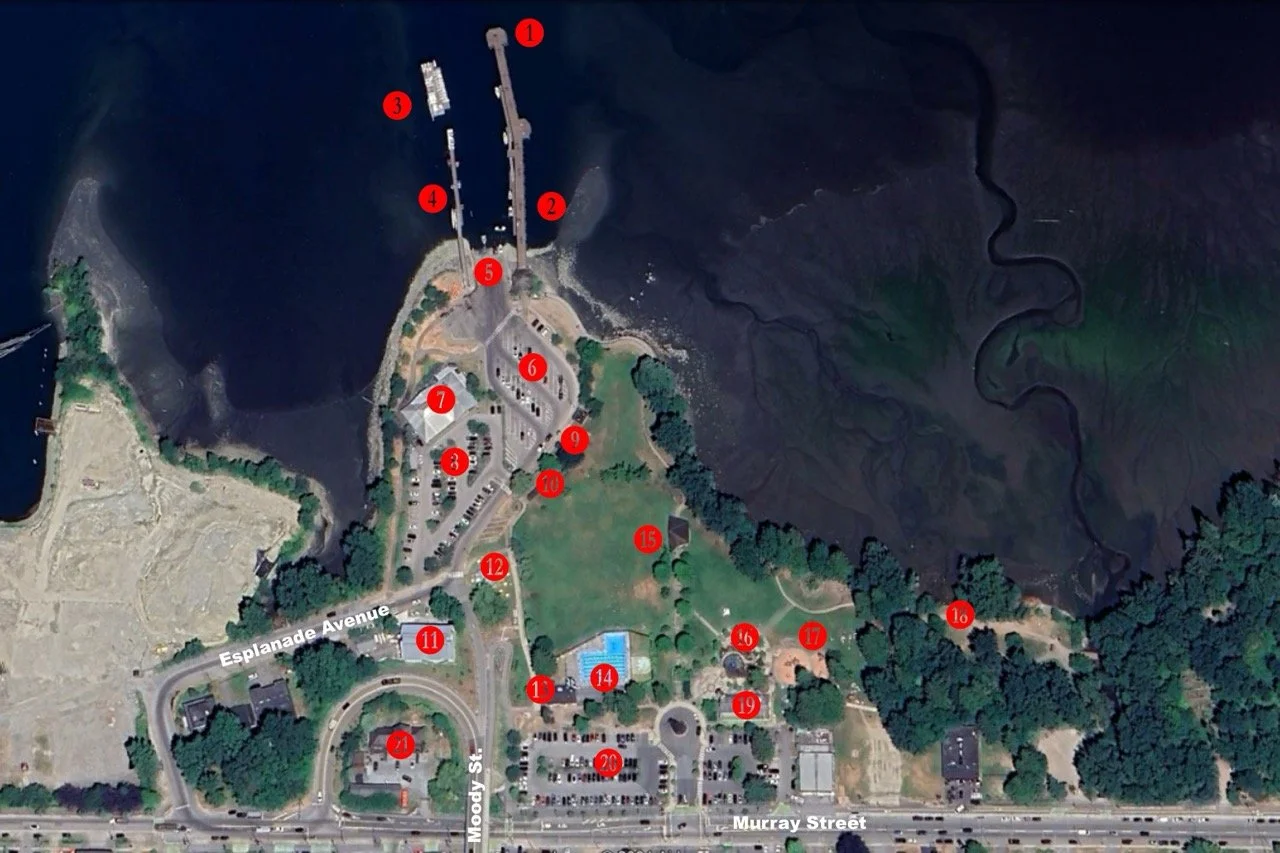A Brief History of Rocky Point Park
Gerrit deWaal
Port Moody Heritage Society
Wednesday, November 20, 2024
All research courtesy of the Port Moody Heritage SocietyPhotographs courtesy of the Port Moody Museum (POMO)
Coast Salish First Nations
Coast Salish First Nations communities were the first to live along the southern coast, including the area known as Port Moody, BC. History has shown that the Squamish, Muskwiam and Kwikwetlem came to the area now known as Port Moody in the summer season and set up camps at the mouth of Noons Creek to hunt and gather shellfish in preparation for the winter.
Rocky Point Park is part of their traditional territory, and the region's natural resources played an essential role in their way of life.
Early Settlers
In 1858, the Royal Engineers, led by Colonel Richard Clement Moody, were sent from England to survey mainland British Columbia. They cleared a trail from New Westminster to Burrard Inlet, later known as North Road, to allow military supplies and personnel to reach New Westminster if attacked from the south.
By 1863, the Royal Engineers were recalled after surveying and constructing major roads. Most sappers chose to stay, accepting 150-acre land grants as compensation. Four sappers, including John Murray, (City News In Brief, 1905) received grants in Port Moody and settled in a community called Aliceville at the end of North Road.
Aliceville began in 1860 with the construction of North Road. In 1874, merchant Webster built a resort hotel on the east side of North Road, operated by J.F. Bonnon. A second hotel appeared on the west side, owned by Mr. Johnson. The site grew into a small settlement with hotels and a general store. In the 1890s, Webster negotiated with the railroad to make the settlement a railway station, naming it Aliceville after his daughter Alice. (Green, 1944)
In 1879, Port Moody was declared the terminus of the Canadian Pacific Railway. By 1880, it had become a boomtown, with railway construction and a wharf and station being built to facilitate supply ships from Britain. Hotels, stores, and houses were built. John Murray and James Clarke started a real estate company to sell lots, and Clarke funded a road connecting to North Road. By this time, John Murray owned about half of the town.
The 1881 survey by F.G. Richards Jr. showed John Murray's Crown Grant land, District Lot 201, including Rocky Point. By 1882, the town of Port Moody's plan was drafted, and lots were sold for $40 (inside) and $50 (corner). Speculation led to a buying frenzy, with some land sold for significant profits within the same year. The population grew rapidly in the early 1880s.
In 1883, John Murray and his family moved to Port Moody. The Canadian Pacific Railway extended its line from Port Moody to Vancouver due to insufficient expansion space in Port Moody, resulting in the town's population remaining stagnant at 250 for nearly twenty years.
Rocky Point and
John Murray, Sr.
Sapper John Murray reserved five acres in the town of Port Moody for himself. The area was called Rocky Point because of a long ledge of boulders at the water line. It was located blocks east of Queen Street.
He obtained a licence from the magistrates in Port Moody in January 1883 and built the Rocky Point Hotel on the site. (See POMO# 1977.015.002 Photo below) A partnership between Hugh Murray and William Sincerbeau, hotel keepers, was dissolved on March 1st, 1884 and the building became a private residence.
The building's design resembled the American Foursquare style of house, which was popular from the late 1800s through the early 1900s. John Murray's house featured two stories with a rectangular footprint, clapboard siding, and a low-hipped roof. (Fire Destroys Hotel, 1911) The main entrance was situated on the west side of the building under a wrap-around porch that extended along the north and west sides of the house giving an unobstructed view of Burrard Inlet. It was situated at the corner of Moody Street and Esplanade, about a quarter of a mile from the Emerson mills and 300 feet back from the sea. (See POMO# 1977.015.001 Photo below)
John Murray Sr. outside the Murray home
These houses were designed to maximize space, light, and airflow, making them a practical choice for many homeowners.
By 1900, John Murray and his family had established their private residence in the building. John had been a member of the Union Lodge, Ancient Free and Accepted Masons, New Westminster branch since 1863. According to page 4 of the Tuesday, January 1, 1901 edition of The Vancouver Daily World, he held a banquet for members of his Lodge at his home at Rocky Point. (Masons at Port Moody, 1901)
There were two other homes known as the Geffard House and the Robinson’s House located on the Rocky Point property. (See Photo POMO# 1979.049.020 below)
Private residences remained on Rocky Point until at least 1916, as indicated by a notice of sale for the Geffard property in the June 15 edition of the Chilliwack Progress newspaper. In April 1905, John Murray Sr. passed away at the age of seventy-two in his home on the Rocky Point reserve. Following his death, the private residence was converted into a hotel called “The Rocky Point Hotel.” (Real Estate Sale, 1916)
A fire broke out on Saturday, June 17, 1911, at the Emerson Sawmill. As Port Moody lacked a fire brigade at the time, mill employees formed a bucket brigade to combat the blaze. The hotel, situated approximately a quarter mile from the Emerson mill, is believed to have been ignited by sparks from the mill fire. Before firefighters could arrive, the fire had escalated to a point where saving the hotel was hopeless. The uninsured building, owned by Mr. Perry Roe and Robert Abernethy, was occupied by two families and several mill employees. (Fire Destroys Hotel, 1911).
The Public and Rocky Point
Rocky Point began to develop as a recreational area in the early 20th century. The arrival of the Canadian Pacific Railway (CPR) facilitated accessibility to the region, encouraging residents and visitors to explore the natural beauty of the area.
The area now known as Rocky Point Park in Port Moody has hosted a variety of events and activities since 1900, reflecting the evolving interests and needs of the community. Here's a broad overview of how the park has been utilized and maintained over the years:
Early 1900s:
Community Gatherings: It was a focal point for community events, picnics, and social gatherings among residents.
Recreation and Leisure: It was used for leisurely activities such as swimming, walking, boating, and enjoying the natural surroundings of Burrard Inlet.
Mid 1900s:
Public Celebrations: The park served as a venue for public holidays and local festivals, especially during the summer.
Sports Events: It hosted sports events like baseball games, fishing competitions, and rowing regattas.
1930: Tables and their conveniences were erected for the use of picnickers and bathers, and materials and labour were donated. Port Moody Women's Institute decided to make more improvements and try to make Rocky Point into a thoroughly modern bathing beach by the following summer. (Local Improvements Objective of Port Moody Institute, 1931)
1947: The new tidal pool was completed and opened to the public. (Pool Ceremony Postponed, 1947) A flapper valve was incorporated into the pool so that at high tide the valve would open and it would automatically close as the tide fell, trapping the water in the pool. The park caretaker, who lived in the park cottage, monitored the pool and would drain it at low tide at least once per week. May 24th was the opening day each year. A change shack with toilets stood near the pool.
The tidal pool was the only swimming pool for miles, and therefore attracted many visitors, not just from Port Moody but from the surrounding areas as well. A significant number of children and adults from the lower mainland learned to swim in the Rocky Point tidal pool.
1949: Improvements included a greensward beside the tidal pool, a renovated concession building, floodlights, and benches and picnic tables provided by the Women's Institute. (Park Gets 'New Look', 1949).
Late 1900s:
Concerts and Performances: Rocky Point was deemed as an ideal setting for outdoor concerts, theatrical performances, and community talent shows.
Community Programs: The park likely hosted fitness classes, arts and crafts workshops, and youth camps.
1940s: During the war, Rocky Point Park served various military purposes. Its scenic landscapes and waterfront made it an appealing location for both strategic and leisure activities. Despite the wartime focus, May Day celebrations continued to be held at Rocky Point, bringing the community together in a time of upheaval.
1950: After World War II, there was a shift toward community development and urbanization in Port Moody. Rocky Point Park gradually transformed into a public space for residents to enjoy recreational activities. The Kiwanis Club donated three teeter-totters for Rocky Point Park. (Kiwanis Club Donated, 1950).
1953: The Kinsmen Organization offers to build an oval wading pool for the use of small children. (Club To Outfit Port Playground, 1952).
Boy Scouts and Army Cadets: Buildings on the site housed these groups. (Army Cadets Meet, 1987).
1960: The City of Port Moody Parks and Recreation Department investigated reports of leaks in the tidal pool gates and concrete wall. (Leaking Probed, 1960) The Tidal pool was closed and replaced with a new in-ground outdoor swimming pool.
1967: In 1967, Rocky Point Park was officially designated as a park, enhancing its accessibility and preservation as a public recreational area.
1988: A new pier was constructed at Rocky Point. The new facility included a 500-foot pier located at the site of what was a boat launching facility. The plans incorporated a new marine underwater habitat, day slips for boat moorage, fishing facilities and restaurant development. The pier was completed in December of 1988. (If I Had A Hammer, 1988) (Port Moody Celebrating 75 Years, 1988).
2000s to Present:
Recreational Facilities: Modern amenities in the park include playgrounds, an outdoor swimming pool, skate parks, and bicycle and walking trails.
Cultural Festivals: Rocky Point Park hosts a variety of multicultural festivals and events that celebrate the diverse heritage of Port Moody’s residents, such as:
Penguin Plunge: Held on January 1st, this annual event invites participants to start the New Year with a refreshing dip in the icy waters of Burrard Inlet.
Golden Spike Days: Celebrated in June, this festival commemorates the completion of the Canadian Pacific Railway with family-friendly activities and live entertainment.
Summer Sunday Concerts: Enjoy live music every Sunday during July and August, featuring a range of genres and local talents.
RibFest: A mouth-watering festival in July that brings together the best rib vendors for a delicious competition.
Holiday Cheer at the Pier: Taking place in November, this festive event features twinkling lights, carolers, and festive games, creating a magical holiday atmosphere.
These varied uses highlight Rocky Point Park's role as a dynamic community hub, adapting to the changing needs and interests of Port Moody residents over the past century.

POMO# 1977.015.002 John Murray building at Rocky Point. The addition at the back was a teahouse.

POMO# 1977.015.001 The Rocky Point home of Sapper John Murray, featuring John Murray Senior, photographed by May Lloyd in August 1900.

POMO# 1979.049.020 In the photo, the John Murray building is prominently shown on the left. The Rocky Point property includes the Geffard House in the center and the Robinson House on the right.

POMO# 2002.004.004 Rocky Point, Port Moody, 1942, Tidal Swimming Pool

POMO# 2013.006.017 Rocky Point, Port Moody, 1942, May Day

POMO# 1009.011.001a Rocky Point, Port Moody, 1947. People gathered for what appears to be a May Queen crowning Ceremony.
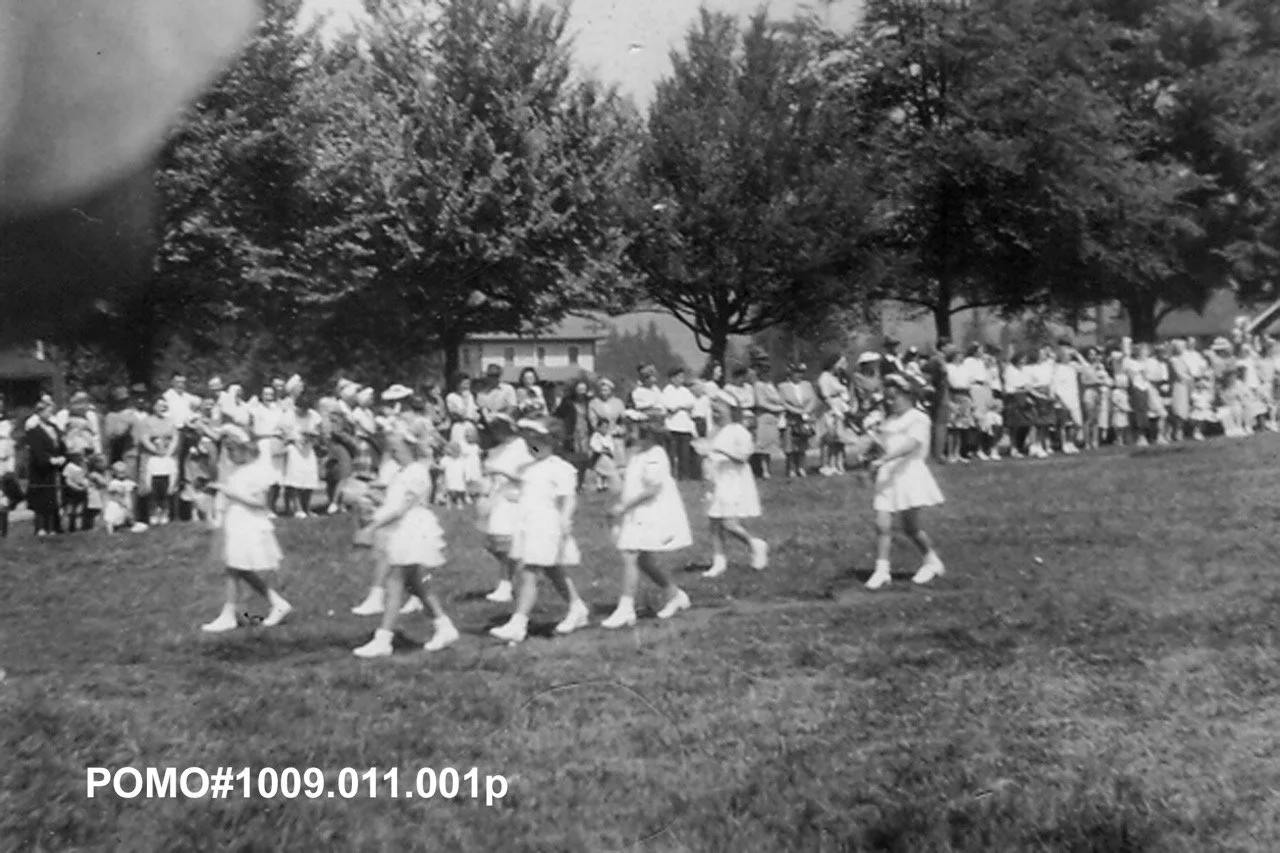
POMO# 1009.011.001p Port Moody May Day, 1947, the May Queen’s court walking along the grass.
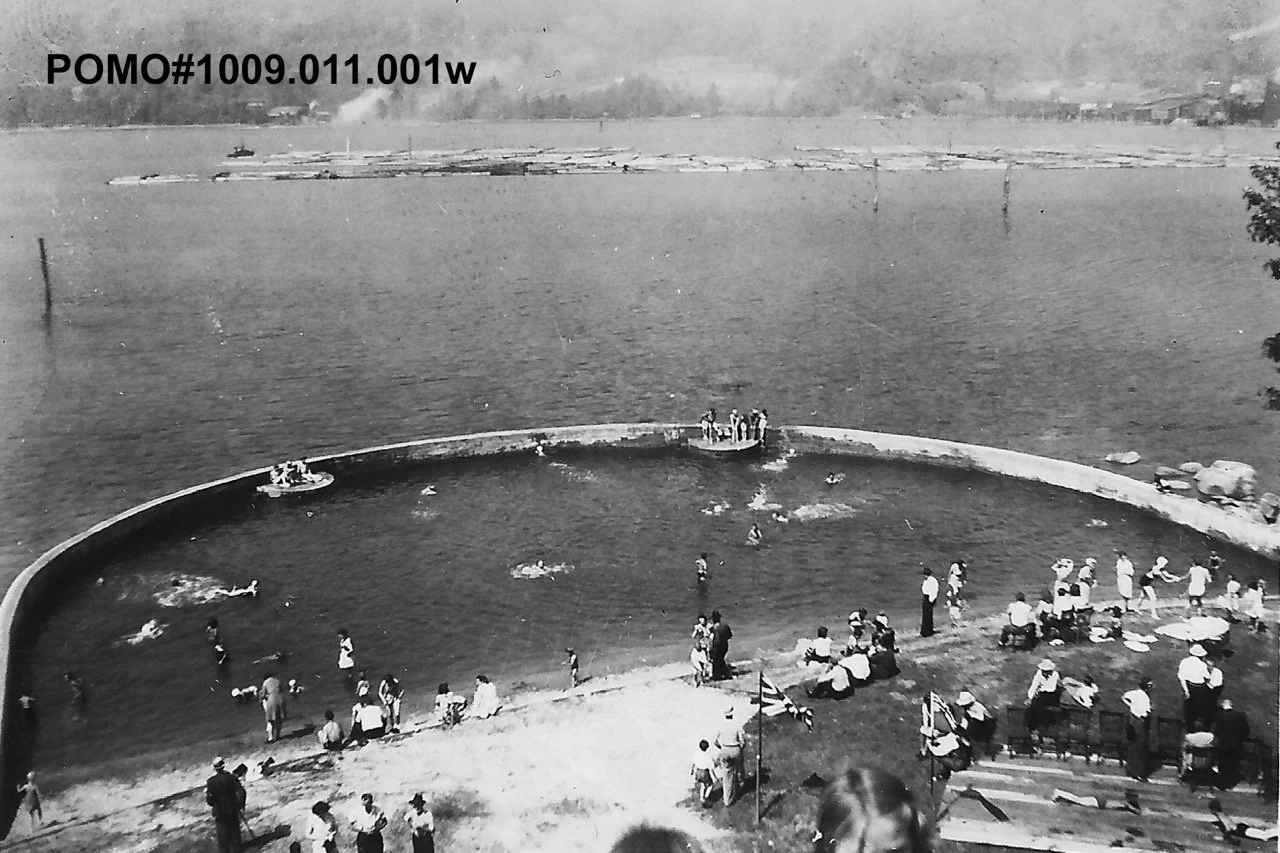
POMO# 1009.011.001w Rocky Point, Port Moody, 1947, people swimming in the Port Moody Tidal Pool, long shot.

POMO# 1009.011.001d Port Moody Carnival at Rocky Point, a crowd of people gathered on the grass. Date Unknown.
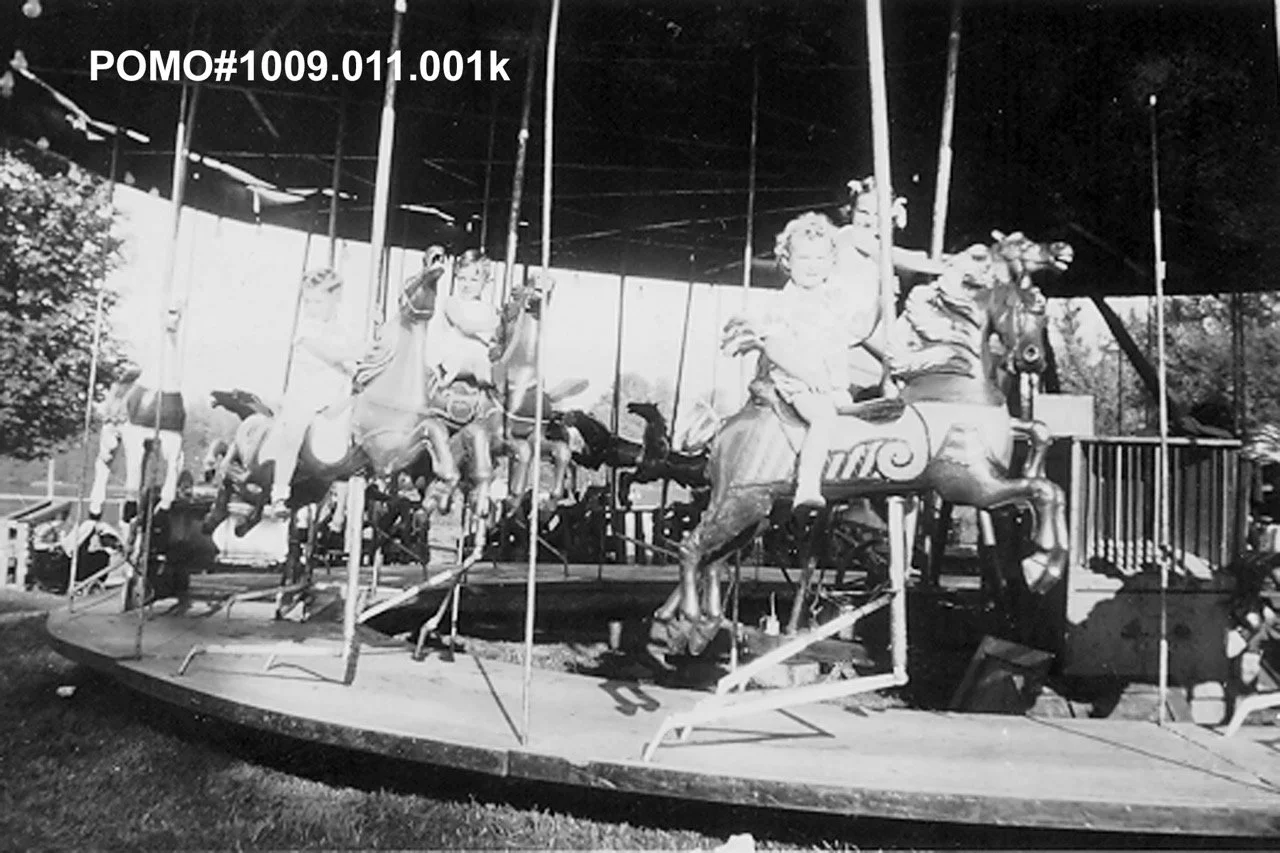
POMO# 1009.011.001k Port Moody Carnival Rocky Point, date unknown.
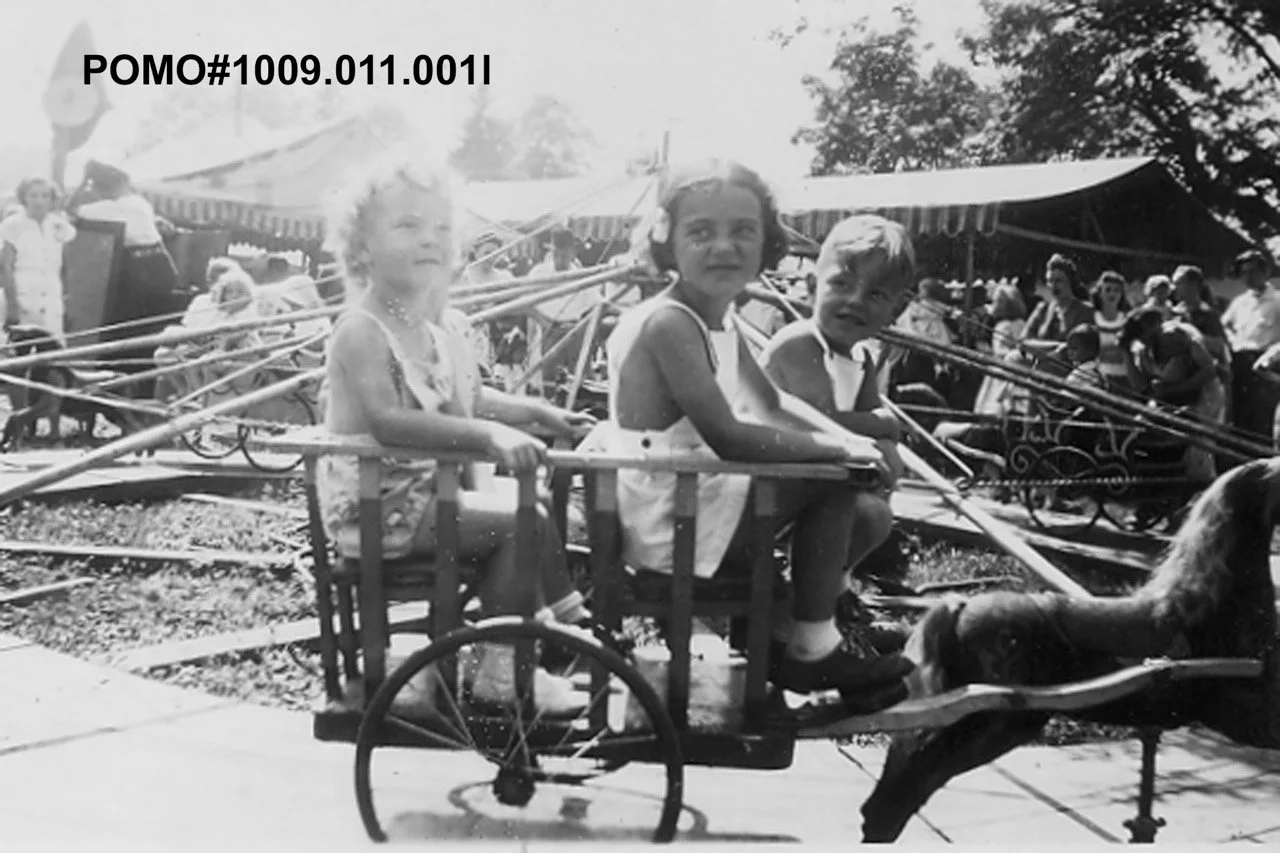
POMO# 1009.011.001l Port Moody Carnival, no date, children on a horse and buggy merry-go-round ride. Date Unknown.

POMO# 1971.052.005 The photograph was taken from the outdoor pool area toward the public toilet building at Rocky Point Park. Date Unknown.

POMO# 1971.082.034 Rocky Point Park Play Area with Swings, slide, teeter-totter, and whirl around. Date Unknown.

POMO# 2004.019.006 Rocky Point Pool, seawater Tidal Pool. , Port Moody, April 1968. Lifeguard stations have been added.

POMO# 2014.016.006 Rocky Point Park Caretaker's Home. 1961.
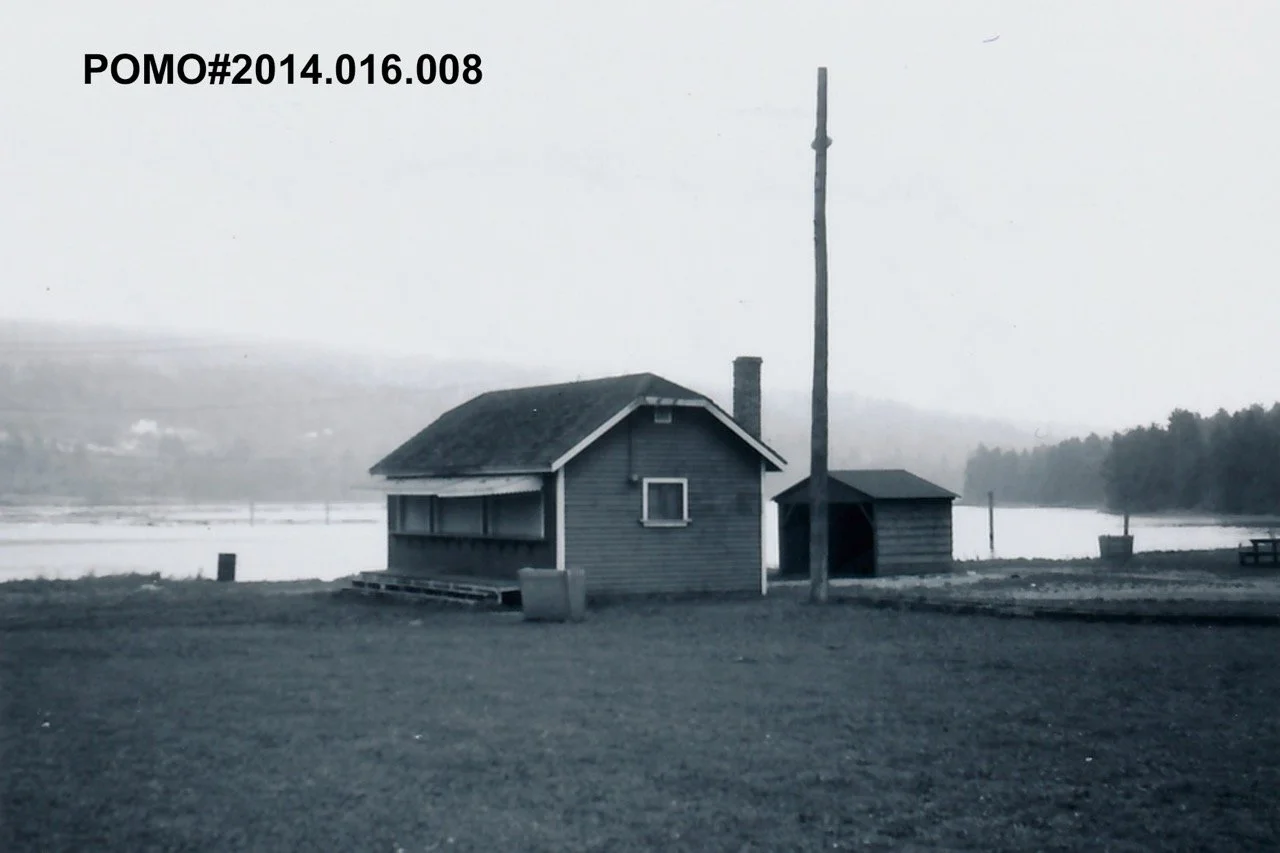
POMO# 2014.016.008 Rocky Point Park Concession Stand. 1961.

POMO# 2014.016.009 Rocky Point Park Public Toilet Building. 1961.

POMO# 2014.016.051 Rocky Point Park Outdoor Swimming Pool. 1972.
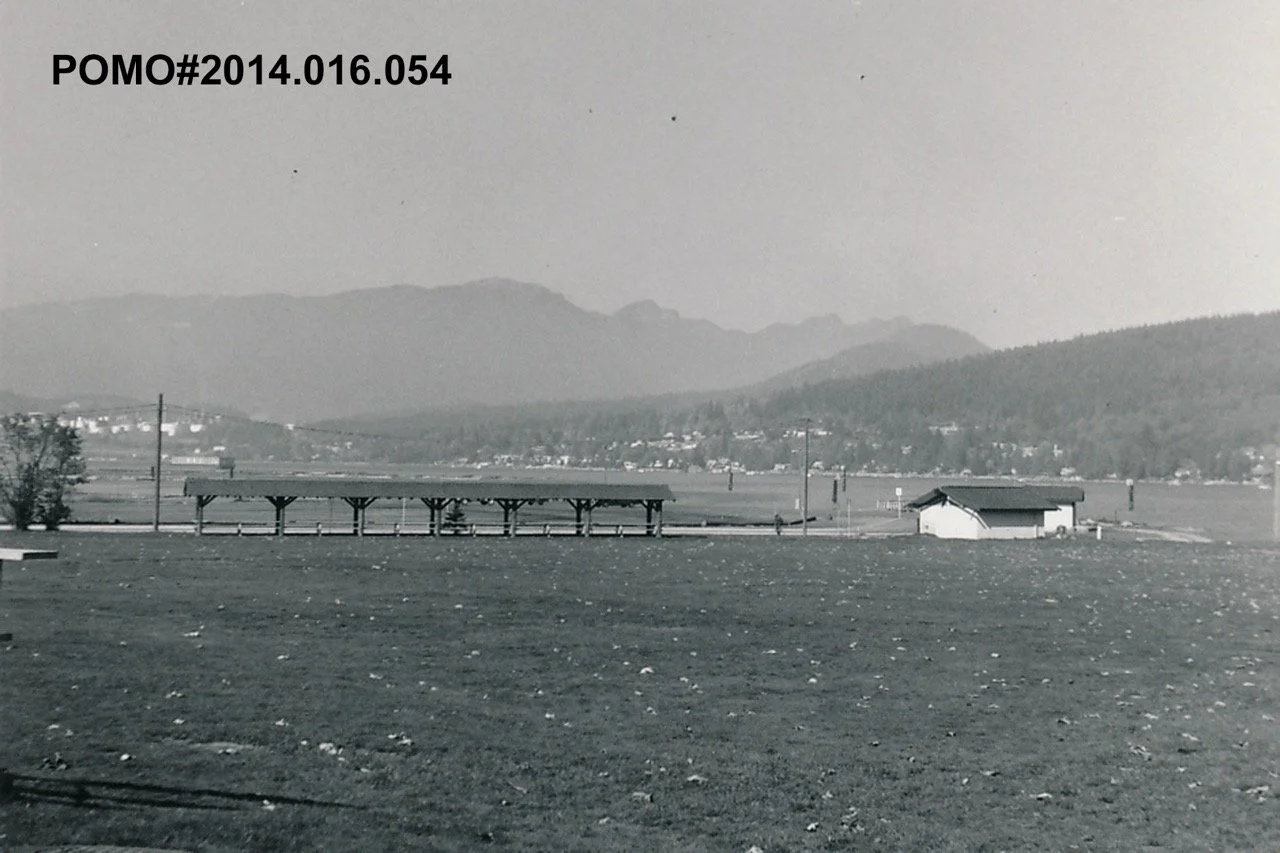
POMO# 2014.016.054 Rocky Point Park Picnic Area. 1972.
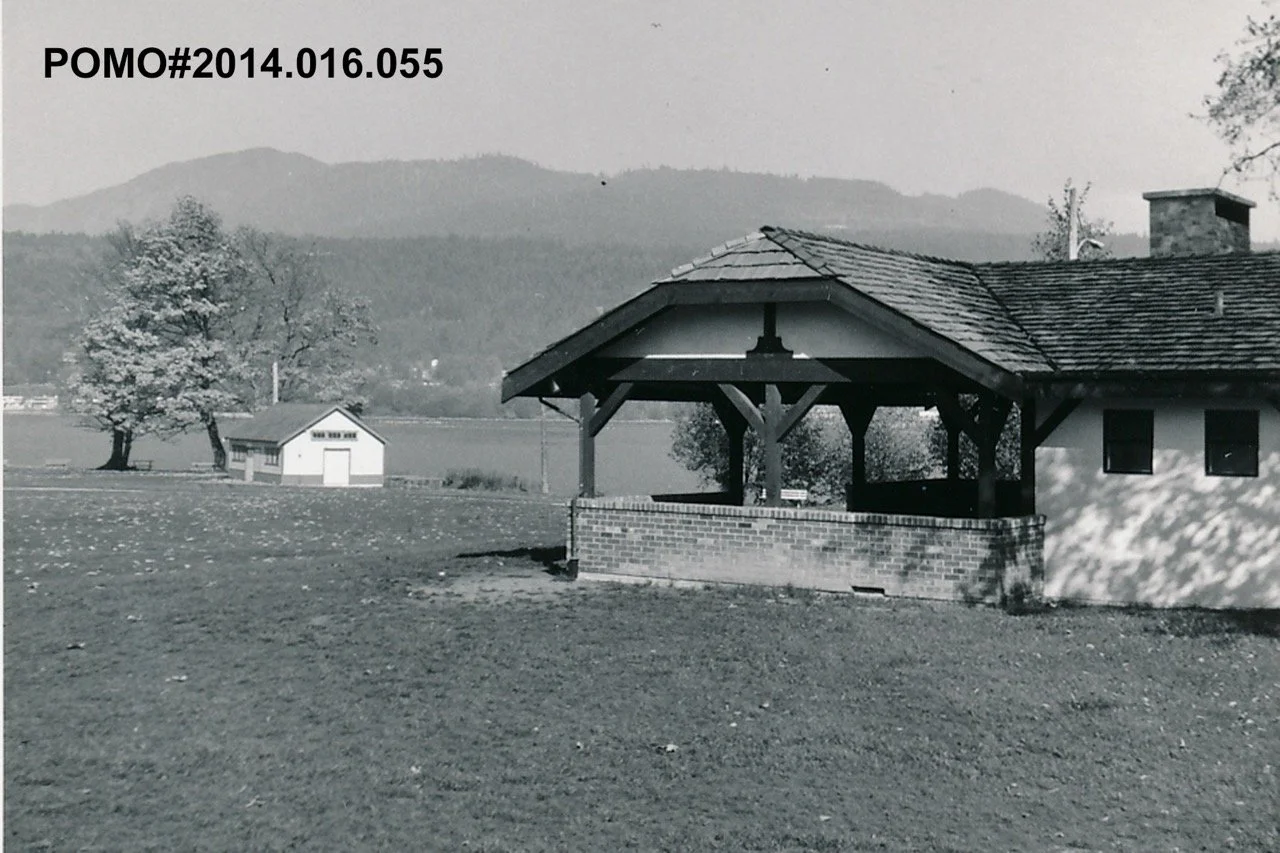
POMO# 2014.016.055 Rocky Point Park Pavilion. 1972.

POMO# 2014.016.057 Rocky Point Park Float. 1972.
B Rocky Point Viewpoint
C Rocky Point Pier
D Kayak Float
E Wharf
F Public Boat Launch
G Boat Launch Parking
H The Boathouse Restaurant
I Boathouse Restaurant Parking
J Rocky Point Kayak
K Picnic Shelter
L Old Mill Banquet Hall
M Pajo’s Fish & Chips Concession
N Rocky Point Ice Cream Concession
O Outdoor Swimming Pool and Change House
P Performance Stage
Q Spray Park
R Playground
S Shoreline Trail
T Restrooms & Custodian’s Residence
U Visitor’s parking
V POMO Museum
Bibliography
Army Cadets Meet. (1987, October 28). The Tri-City News, p. 30. Retrieved July 9, 2024, from Newspapers.com: https://www.newspapers.com/image/561459654/
City News In Brief. (1905, April 17). The Victoria Daily Times, p. 5. Retrieved July 2, 2024, from Newspapers.com: https://www.newspapers.com/image/505195362/
Club To Outfit Port Playground. (1952, September 5). The Province, p. 20. Retrieved July 2, 2024, from Newspapers.com: https://www.newspapers.com/image/499942263/
Fire Destroys Hotel. (1911, June 20). The Province, p. 20. Retrieved July 2, 2024, from Newspapers.com: https://www.newspapers.com/image/498042053/
Green, G. (1944, March 4). Aliceville Now B.C. "Deserted Village". The Province, p. 46. Retrieved November 19, 2024, from Newspapers.com: https://www.newspapers.com/image/499726545/
If I Had A Hammer. (1988, December 31). p. 71. Retrieved November 7, 2024, from Newspapers.com: https://www.newspapers.com/image/495108067/
Kiwanis Club Donated. (1950, June 26). The Vancouver Sun, p. 17. Retrieved from Newspapers.com:
https://www.newspapers.com/image/491760183/
Leaking Probed. (1960, June 2). The Vancouver Sun, p. 8. Retrieved July 2, 2024, from Newspapers.com: https://www.newspapers.com/image/492103846/
Local Improvements Objective of Port Moody Institute. (1931, October 13). The Province, p. 11. Retrieved from Newspapers.com: https://www.newspapers.com/image/500604740/
Masons at Port Moody. (1901, January 1). The Vancouver Semi-Weekly World, p. 4. Retrieved from Newspapers.com: https://www.newspapers.com/image/776160520/
Park Gets 'New Look'. (1949, July 8). The Province, p. 38. Retrieved July 2, 2024, from Newspapers.com: https://www.newspapers.com/image/500018147/
Pool Ceremony Postponed. (1947, July 12). The Province, p. 2. Retrieved July 12, 2024, from Newspapers.com: https://www.newspapers.com/image/499809615/
Port Moody Celebrating 75 Years. (1988, March 9). The Tri-City News, p. 22. Retrieved November 7, 2024, from Newspapers.com: https://www.newspapers.com/image/561453438/
Real Estate Sale. (1916, June 15). The Chilliwack Progress, p. 6. Retrieved from Newspapers.com: https://www.newspapers.com/image/43189165/

